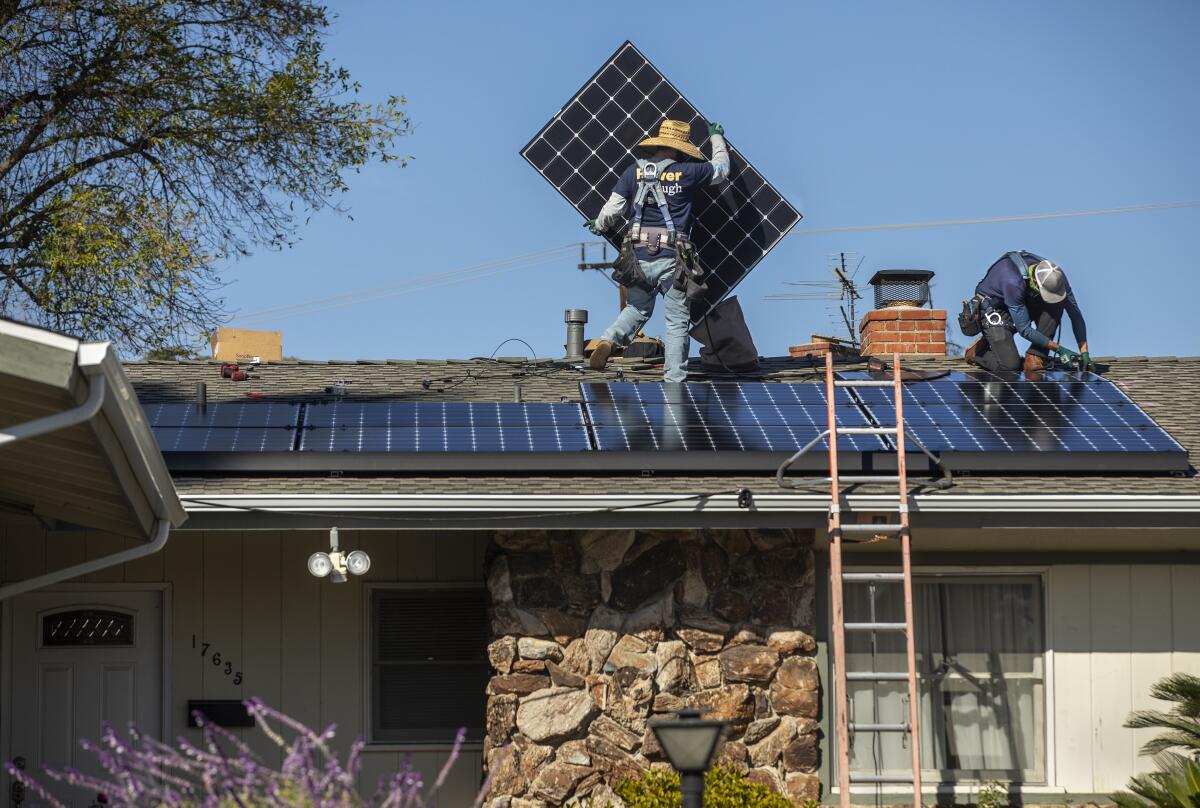Editorial: The new plan to slash rooftop solar incentives is better — but still too extreme

Nearly a year after announcing a plan to gut California’s successful rooftop solar incentive program, state regulators have released a revised version that does away with some of the most extreme provisions pushed by the state’s big monopoly utility companies. So it may be tempting to view the California Public Utilities Commission’s latest proposal as a reasonable middle ground.
That would be a mistake.
Yes, the new plan, released earlier this month , removes a planned “grid participation charge” that would hit typical residential customers with an additional $50 a month in fees and was correctly decried as a “solar tax.” It would also allow existing solar customers to be paid current rates for the excess power they provide to the grid, rather than having those rates phased out over time. And households that go solar within five years after the decision is adopted would receive higher credits to supplement the reduced rates during the first decade of their system’s operation than under the December 2021 proposal.
The proposal would drastically cut the subsidies new solar customers receive, making it less affordable for households to go solar, hampering California’s shift to renewable energy that is crucial to reducing planet-warming emissions and fighting climate change. That’s not an acceptable compromise.
Atty. Gen. Rob Bonta is pushing back on the lie that plastic grocery bags used in California are recyclable. Good for him.
The California Solar & Storage Assn., a trade group representing the rooftop solar industry, estimates that the latest proposal would cut the amount new solar customers are paid for the unused electricity they generate from about 30 cents per kilowatt-hour today to just over 5 cents. That will increase the time it takes to recoup their investments from less than seven years to more than 10 years. Going solar would be significantly less attractive, especially for middle- and low-income customers.
The CPUC said its plan would allow new customers to pay off their solar and any paired battery storage systems in nine years or less, but the rooftop solar industry says that is based on lowball figures that underestimate the actual cost of installation, which has jumped recently due to supply chain issues.
Ten years is certainly better than the roughly 15-year payback time projected under the previous plan. But it still greatly reduces the effectiveness of one of California’s most popular and successful renewable energy programs. Regulators can and should do better.
A proposed wildlife ordinance for L.A. is just what animal — and humans — need.
With an average-sized rooftop system running about $16,000, after the federal tax credit, solar remains out of reach for many Californians, even under today’s rules. But the number of low- and middle-income people installing rooftop panels has been ticking upward in recent years. Data from Lawrence Berkeley National Laboratory show that 12% of California solar adopters in 2021 had incomes below $50,000, compared with 9% in 2010, and that 28% had incomes between $50,000 and $100,000, up from 24% in 2010. Those trends are encouraging, but are at serious risk of stalling under this proposal.
The program, known as net energy metering, has been at the center of a high-stakes fight over racial and economic justice and who will benefit from the shift to renewable energy.
On one side are the state’s three big investor-owned utilities, including Southern California Edison, labor unions representing workers that build large-scale solar farms and ratepayer watchdogs, who have pushed to dramatically scale back the state’s solar subsidies. They say the current system unfairly benefits solar customers, who tend to be wealthier and whiter, by shifting billions in utility costs to lower-income communities of color and renters who don’t have solar, and that the PUC’s revised proposal is too modest. On the other side are solar installation companies and environmental activists who want solar power to be decentralized, and dismiss the notion of shifting costs. They accuse the utility companies of going after rooftop solar because it threatens their monopoly.
Some people are asking for signatures with false or misleading descriptions of the petitions they’re circulating.
Rolling back solar subsidies would put California in the awkward position of cutting against actions by the federal government to encourage solar power. The Inflation Reduction Act signed by President Biden in August increased the federal tax credit for people who install rooftop solar from 26% to 30% and extended it through 2032.
Regulators still have time to improve the proposal before voting on it next month, by among other things slowing down the reduction in compensation to solar customers. That would allow more time to ramp up the market for solar systems paired with battery storage, which crucially helped keep the lights on during a brutal September heat wave that pushed California’s electrical grid to its limits. As it is, only about 14% of solar customers install batteries, and it’s no wonder: They add $10,500 to the cost of an average system, after tax credits.
Taking a hammer to a cornerstone of California’s renewable energy economy at a time when the need is higher than ever is a bad idea. It’s also counterproductive when California is increasing its climate ambitions with a raft of new legislation signed by Gov. Gavin Newsom this year. Rooftop solar is key to that transition, and this is no time to slow it down.
More to Read
A cure for the common opinion
Get thought-provoking perspectives with our weekly newsletter.
You may occasionally receive promotional content from the Los Angeles Times.













